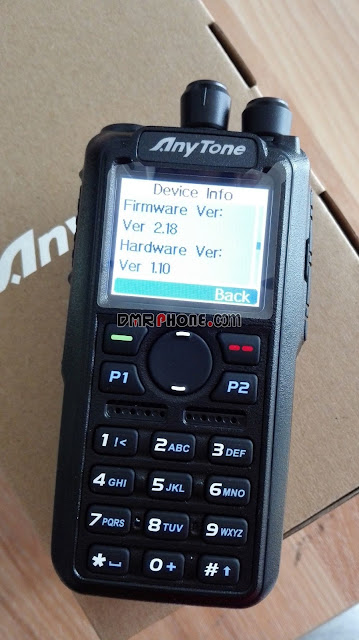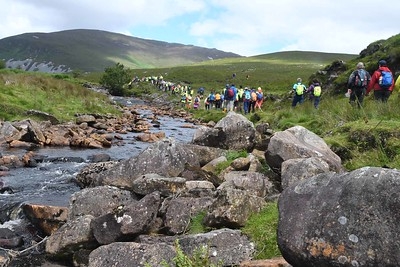On an annual basis, the Galway VHF Group provide communications for the Connemara Ultra Marathon. This generally occurs on HF using 80 metres. We were minus two key personnel this year, Arthur, EI7GMB, and Gerry EI8DRB. We normally run two HF base Stations. One in the Maam Community Centre at the bottom of the Maam Valley and the other at Peacock's at Maam Cross.
As seen from the map the terrain is not VHF Friendly so HF has to be employed. The Use of 5 MHz NVIS would be out of the question as it is unlikely that anyone in the group would go out and purchase such a mobile antenna. From a base perspective NVIS would be possible. For the area covered, 80 metres Ground Wave is sufficient and adequate for the majority of the course.
This year, given the reduction in operators, it was necessary to put into practice some other means of communication based on observations from previous years. APRS was one idea, DMR via Hotspots, and PTT over Cellular using the INRICO TM-7 was used with reservation.

The Maam Community Centre
The first task was to set up the VHF antenna and secure contact with the Medical Centre at Maam Cross. The antenna was a VHF colinear on a Fibreglass hoisted into a tree. Not the best but it did work fine.
.
The next task was to set up the HF antenna as soon as possible. The dipole antenna was mounted on a fibreglass pole secured to a fence post at a good height. This only took about 10 minutes to set up. As good strong signals were received on 2 metres in Maam Cross we decided to make this the primary frequency for that location HF was only used if here was a need. There wasn't on this occasion.
The ends of the dipole were secured to a flagpole at one and and another fibreglass pole at the other. It was surprisingly easy to set this one up.
A picture of John's bottom. I guess he was making last adjustments to his HF system before going mobile. The mobile whips are excellent if the earthing is ok in the car, but if it is poor, the tuning is difficult. A quick call to Tom in Maam Cross and confirmation of good clear signal was made.
The Base Station was a CODAN commercial HF system set up on 3750 KHz. The DMR rig was connected into the system via WiFi and also the DV4 Mini. C4FM was used on the FTM100 in the background.
All stations were now up and running and in contact. Joe set off for Leenane. Steve was through Leenane at this stage and heading for the Inagh Valley to the start of the Full Marathon. Communication via DMR and the TM-7 proved succesful with crystal clear audio on both methods of communication. Joe's car had the FTM100 on C4FM and also the Inrico TM7 in the foreground. A GD-77 handheld was in use as well.
Steve, EI5DD, had the Inrco system, the FTM 400 on C4FM, and also a Motorola DM4600 for test throughout the event. The TM-7 had APRS Droid installed and sent position reports at intervals.
The portable, self contained Hotpspot system with Power pack, Cellular WiFi, Router with Ethernet Port for the Shark RF Openspot and a spare UHF handheld just in case (sic).
The full marathon started on time with a huge number present. Behind these runners, were the ultra marathon runners.
At he very back of each section of the marathon, were the Order of Malta Ambulance and the a mini bus to look after anyone in difficulty of those who wished to drop out at any point.
In Leenane the first of the runners were beginning to arrive from the Full Marathon.
The weather was not wonderful with some heavy showers here and there but it was not too cold. There were probably only a couple of cases of hypothermia this year and very few injuries. The above runners had approximately 10 more miles to run but the last few miles were up hill to the finish.
Once the last of the walkers/runners had passed the point shown above the net transferred to C4FM as all cars were now in range of the centre. The HF operator still communicated on HF whilst checking 5 miles back to see if there were any stragglers.
As always it is far easier to take equipment down than put it up. The HF antennas were removed and the station packed. The last of the runners passed the Centre and any other communications were now confined to VHF.
The Medical Centre was established at the finish line. Many of the runners were suffering from exhaustion but a rest and some high energy drinks slowly brought them round. Some started to feel cold once they stopped running and needed to be wrapped in foil blankets to bring up their temperature.
What did we learn from the day?
1) HF is still the most reliable method of communicating through mountainous terrain.
2) The Cellular network was good as there was an almost continuous strong signal in the Connemara area. This was a surprise but bear in mind, the TETRA system had worked perfectly for the Order of Malta.
3) DMR worked well and there were other interesting possibilities for this system.
4) PTT over Cellular Networks was perfect and vey clear. It has a place in the scheme of things.
5) Forget 2 metres. At best, it was useful up to 7 Kms and occasionally gave us a surprise but not enough to warrant reliability.
We thank the team Andrew EI3FEB Net Controller, Tom EI2GP on standby at the medical Centre, John EI1EM for his constant access to base on HF, Joe EI3IX stationed in the Leenane area and Steve EI5DD mobile between the Inagh Valley and the finish line. We thank Mark Bannon, EI6HPB, for coming along to view our activities and assist where required. We will have plenty of work for him in future! He made a few useful contacts whilst out and about. It was good to work with the Order of Malta and the Bike Marshals on this event.
The various methods of communication were rigorously tested and we now know their limitations. A check of the APRS map shows the coverage from the Inrico from the APRS signal emitted via Cellular data. Note, that it was not covering the first part of the Marathon as EI5DD/M did not follow the section before the Full Marathon. It would have, undoubtedly, covered that area if this area had been travelled.
The map shows the track from the start of EI5DD's Journey from Galway to the event and back home. APRS proved the effectiveness of the Cellular data system and hence the TM-7's efficiency and also the potential of DMR. Perhaps APRS Driod for Mobile Phone should be a must for all participating.
It would be unwise to just go in blind to such an event and presume that the Cell network would work perfectly in mountainous terrain. A very wise thing to check the area first. Our Group always have the areas checked out beforehand and in many cases we would be stomping over old ground.





































































